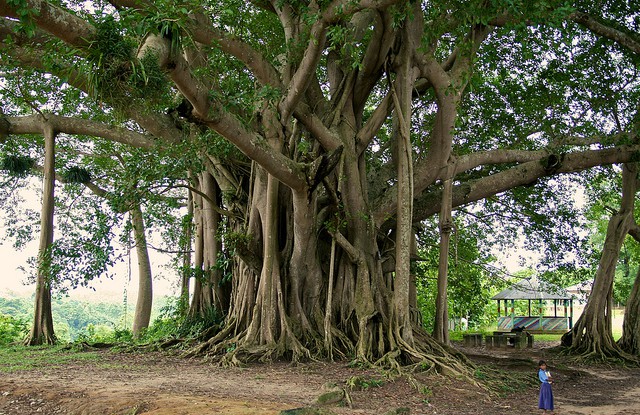
BOGOR, Indonesia (6 August, 2013) – A large-scale study has found that a handful of big trees store up to half the above-ground biomass in tropical forests, raising implications for forest management and climate change mitigation.
Trees remove carbon from the atmosphere as they grow, storing it in leaves, woody tissue, roots and organic matter in soil, and playing a critical role in regulating the Earth’s climate and mitigating climate change.
Calculating above-ground biomass — which comprises all living biomass, or organic material, above the soil, including stem, stump, branches, bark, seeds and foliage — helps scientists measure the role of forests as carbon sinks in mitigating climate change.
The study was led by Ferry Slik, a scientist at the Centre for Integrative Conservation, Xishuangbanna Tropical Botanical Garden, Chinese Academy of Sciences.
Slik, who has previously explored above-ground biomass in tropical forests on local and regional levels, wanted to examine these issues on a global scale. After scanning the literature for scientists doing tree inventories, he invited them to join his study.
“Most of the time they reacted positively,” he said. “They saw the advantage of being part of a larger-scale project.”
The study, published recently in Global Ecology and Biogeography, ultimately involved some 60 scientists. They examined data on 192,308 trees at least 10 cm in diameter in 120 lowland moist old-growth forest locations in South America, Africa and Asia. Large trees were defined as those measuring at least 70 cm (28 inches) in diameter at breast height (dbh).
Among their results, the researchers determined that bigger trees play a larger role in storing biomass than previously thought. “Only 3 percent of the forests are made up of big trees, but these trees store up to half the biomass,” Slik said. “If just a few of these large trees die, it immediately has a major impact.”
They also concluded that climatic variables affect the density of large trees and above-ground biomass, which means climate change will affect the storage of tropical forest biomass. “If temperatures keep rising — a 2 to 6 degree (Celsius) rise is predicted over the next century — it will likely negatively affect these big trees,” said Slik.
The results have implications in several areas. “Now we know these big trees are important for biomass,” Slik said, “but we still don’t know much about the dynamics of these trees — how fast they grow, how old they get — because researchers have been concentrating on relatively small plots which contain few big trees due to their low density.”
With advances in remote sensing techniques, he said, it’s relatively easy to recognize these big trees and make accurate estimates of biomass. Researchers should start focusing more on bigger trees in larger plots, he said.
Since the publication of the paper, Slik and his colleagues have identified 3,000 more plots encompassing 800,000 trees and 20,000 species. More research papers will be forthcoming, he said.
The importance of these large trees should also be a wake-up call for the forestry industry. “Logging usually concentrates on larger trees,” said Slik. “Maybe it’s better to focus on intermediate-size trees. Logging could be managed in a more environmentally friendly way.”
“The biggest threat to these large trees is human intervention in forests,” he added. “As soon as logging or agricultural activities begin, these trees are usually the first to disappear. It takes a very long time to get them back.”
For more information on subjects discussed in this article, please contact Ferry Slik at ferryslik@hotmail.com or Terry Sunderland at t.sunderland@cgiar.org
This work forms part of the CGIAR Research Program on Forests, Trees and Agroforestry and was supported by the Instituto Nacional de Pesquisas da Amazônia (INPA), Silvicultural Treatment for the Regeneration of Logged-over Forest in East Kalimantan (STREK), PlotNet Forest Database (Lopez-Gonzalez et al. 2010) and the Tropical Ecology Assessment and Monitoring Network (TEAM). In addition, many researchers shared their tree inventory data sets with the authors.
We want you to share Forests News content, which is licensed under Creative Commons Attribution-NonCommercial-ShareAlike 4.0 International (CC BY-NC-SA 4.0). This means you are free to redistribute our material for non-commercial purposes. All we ask is that you give Forests News appropriate credit and link to the original Forests News content, indicate if changes were made, and distribute your contributions under the same Creative Commons license. You must notify Forests News if you repost, reprint or reuse our materials by contacting forestsnews@cifor-icraf.org.